
>
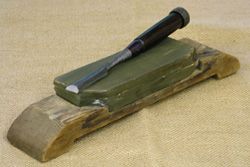
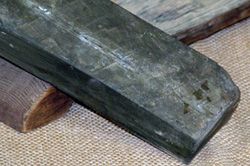 In the 1980's I had a small workshop beneath a cobbler's shop in the Beaches area of Toronto. One day a Japanese friend of mine brought me three tools which had belonged to his grandfather, Mr. Yashimoto. All are curious, but the sharpening stone is probably the most interesting of all. This is a natural waterstone that has been hand-hewn from a rough piece of rock. It is not a perfect rectangle and the underside of the stone still bears the marks of the cold chisel that was used to shape it.
In the 1980's I had a small workshop beneath a cobbler's shop in the Beaches area of Toronto. One day a Japanese friend of mine brought me three tools which had belonged to his grandfather, Mr. Yashimoto. All are curious, but the sharpening stone is probably the most interesting of all. This is a natural waterstone that has been hand-hewn from a rough piece of rock. It is not a perfect rectangle and the underside of the stone still bears the marks of the cold chisel that was used to shape it.
One end of the stone is complete but is not cut at 90° to the sides. The other end has a sizeable chip missing. One wonders if that was a Japanese 'oops' or if the stone was shaped around the size of the rock it was cut from.
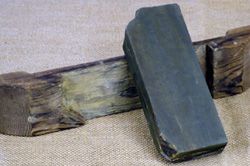 Regardless, the pine base has been cut to suit the shape of the stone and accommodates the missing chip. The base also has two pins on the underside, at one end, to secure it on a bench top when in use.
Regardless, the pine base has been cut to suit the shape of the stone and accommodates the missing chip. The base also has two pins on the underside, at one end, to secure it on a bench top when in use.
I use the stone constantly and find it is very close to an 8000 grit, capable of polishing the underside of a chisel. It is not nearly as soft as a Gold Stone, which makes it very handy for sharpening smaller chisels and carving tools that tend to dig in with the slightest unintended twist of the wrist. Many years ago, when Lee Valley had just opened its store on Steeles Avenue in Toronto, I took the stone to them and they were quite interested in acquiring it from me. Alas, I was not prepared to part with something so rare and precious, and it wasn't really mine to give away, so I still have and treasure it.
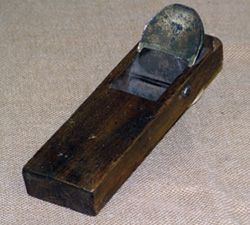
 The plane is typical of the Japanese style but I suspect that the body was probably made by Mr. Yashimoto himself. Recently I learned that Japanese cabinetmakers would normally buy the blade alone and then make the body themselves, and this bears up upon examining the plane. The blade itself is stamped with several Japanese characters which would lead you to think that it was made by a manufacturer. However, the wedge has a definite homemade look to it and the cross pin is nothing more than a 6" nail cut to length.
The plane is typical of the Japanese style but I suspect that the body was probably made by Mr. Yashimoto himself. Recently I learned that Japanese cabinetmakers would normally buy the blade alone and then make the body themselves, and this bears up upon examining the plane. The blade itself is stamped with several Japanese characters which would lead you to think that it was made by a manufacturer. However, the wedge has a definite homemade look to it and the cross pin is nothing more than a 6" nail cut to length.
The wood for the body is a piece of quarter-sawn oak that has been carefully selected and cut in such a manner that the annual rings are at precisely 90° to the sole. The long edges of the sole have been chamfered, but the sole has not been relieved between the toe, heel and mouth as is sometimes seen on Japanese planes. The plane cuts extremely well and is used occasionally just for the sheer joy of it and for the connection to a craftsman from another culture and time.
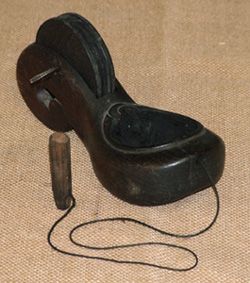
 The Japanese chalkline or inkline, actually called a
sumitsubo
, is carved from oak and appears to also have been made by the craftsman rather than purchased. The shape and decoration are precise enough, but the crank for reeling in the cord has a homemade look to it which makes me think that this may also have been made by Mr. Yashimoto. The cord, which will leave the line when snapped against the wood board to be marked, runs through cotton wadding to pick up the powdered ink. Although the Western tool is very similar and uses chalk or pencil, the Japanese cabinetmakers preferred ink and a finer cord which produced a thinner line and resulted in higher tolerance/accuracy.
The Japanese chalkline or inkline, actually called a
sumitsubo
, is carved from oak and appears to also have been made by the craftsman rather than purchased. The shape and decoration are precise enough, but the crank for reeling in the cord has a homemade look to it which makes me think that this may also have been made by Mr. Yashimoto. The cord, which will leave the line when snapped against the wood board to be marked, runs through cotton wadding to pick up the powdered ink. Although the Western tool is very similar and uses chalk or pencil, the Japanese cabinetmakers preferred ink and a finer cord which produced a thinner line and resulted in higher tolerance/accuracy.
This inkline is quite simple in its design, but some are extremely ornate with a high level of carving. The Balinese also produced a very similar tool called a sepat , as did the Indonesians, although I have no idea what they called their version. All of them tended to be carved with mythical creatures, dragons, frog, horses and birds. I rarely use the tool but do enjoy owning it. The cord is very fragile and can no longer be 'snapped', but I hesitate to change it as it would detract from the authenticity of the tool.